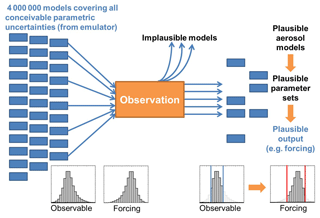A Process System Approach to Constrain Aerosol Uncertainty from Regional to Global Scales
Are you interested in helping solve a long-standing climate science challenge using large ensembles of climate simulations and innovative model-observation fusion methods? Do you have a background in a) physical science and/or b) statistics, and want to advance your career in one of the world’s leading atmospheric science institutes?
This PhD studentship offers a place within the thriving aerosol-cloud research group in the Institute of Climate and Atmospheric Science, with a potential research placement at the National Centre for Atmospheric Science in Boulder, Colorado.
The challenge
Human emissions of aerosol particles have caused a large cooling effect on Earth’s climate, mostly by affecting cloud brightness, that has partially offset global warming rates. The magnitude of the effect is highly uncertain and feeds through to estimates of a) how much Earth will continue to warm in the future as greenhouse gases rise (Peace et al., 2020) and b) associated climate impacts (e.g. Yamazaki et al., 2024). Uncertainty leads to a lack of urgency across the international community to make changes that will reduce the risks associated with climate change.

Huge efforts to improve representations of aerosol physical processes in climate models over several decades have only had partial success in reducing model uncertainty (Johnson et al. 2020). In part, this is because these efforts to force climate models to match observations do not separate the effects of structural model deficiencies (the way processes are represented in models) and uncertain process-related parameters in the model equations (parametric uncertainty; Regayre et al., 2023). Also, most observational data sets only provide measurements of the current state of the atmosphere, whereas to learn about how the atmosphere is changing in response to aerosol particles, we urgently need more widespread observations of physical processes, related to the changing state of the atmosphere (e.g. D’Alessandro et al., 2023).
High-resolution regional models capture process-level information about aerosol particles and cloud physics, that control how clouds respond to aerosol pollution (Field et al., 2023). Yet so far these gains in regional scale model fidelity have not translated into reduced climate uncertainty. If high-resolution models were faster, we would base our uncertainty estimates on large ensembles of global scale simulations with high-quality process representations. Unfortunately, high-resolution models are costly, so instead our uncertainty estimates are based on ensembles of relatively coarse-resolution models which have much simpler representations of important aerosol and cloud microphysical processes. So, to reduce the uncertainty related to man-made climate change and future warming, we need a deeper understanding of how regional-scale model uncertainties translate into uncertainties at the global scale.
The Opportunity
In this PhD project, you will identify the processes that cause aerosol and cloud uncertainty in a hierarchy of UK climate models, from regional to global scales. The project offers the opportunity to develop expertise in creating ensembles of model simulations, advanced data science techniques and model synthesis with cutting-edge observational data. Our aerosol-cloud research group at Leeds, in collaboration with the UK Met Office have created multiple ensembles of regional and global scale simulations – referred to as perturbed parameter ensembles (PPEs). We use machine learning techniques to convert these relatively small ensembles into millions of model variants that can be analyzed and evaluated against observations (Fig. 2). This PhD research provides unique opportunities to a) create bespoke PPEs of the soon-to-be-released 2nd version of the UK Earth System Model (UKESM2), and b) challenge models to match process-based observational data provided by project partner, Christina McCluskey, at the National Centre for Atmospheric Research (NCAR) in Boulder, Colorado.

Your project objectives will include:
- Creating PPEs of UKESM2 at regional and global scales, to identify how uncertainties related to aerosol and clouds affect model uncertainty. You will leverage Leeds’ extensive experience with PPE design and analysis, and in developing statistical techniques to quantify causes of model uncertainty.
- Fusing models with process-based observational data from targeted flight campaigns processed into a ‘model-ready’ form in the NSF NCAR INtegrating Field Observations and Research Models (INFORM) project. These observations cover variables such as updraft velocity, aerosol concentration, and cloud droplet number concentration. These process-based measurements—collectively capturing rapid cloud adjustments to aerosol changes—are seen as essential for reducing model uncertainty, particularly in ‘transition regions’ where stratocumulus clouds break up into disorganised cumulus cloud.
- Quantify uncertainty across model scales by contrasting PPEs of high-resolution regional models with PPEs of global scale models. You will use these PPEs to a) identify the most important model parameters and processes at each scale, and b) evaluate how uncertainties propagate across scales.
- Identifying structural model errors and make recommendations for model development. By evaluating aerosol-cloud process representations across scales, you will identify structural model errors in the UKESM2, pinpointing priority areas for future model development. Early success in this area will reveal an opportunity to implement code changes to improve parameterizations of aerosol and/or cloud microphysical processes and improve UK model skill at making climate projections.
Further Reading:
- Regayre, L., Deaconu, L., Grosvenor, D., Sexton, D., Symonds, C., et al., Identifying climate model structural inconsistencies allows for tight constraint of aerosol radiative forcing, 2023, Atmos. Chem. And Phys., 10.5194/acp-23-8749-2023
- Carslaw, K., Lee, L., Regayre, L., and Johnson, J. Climate Models Are Uncertain, but We Can Do Something About It, 2018, EOS, 10.1029/2018EO093757
- Johnson, J., Regayre, L., Yoshioka, M., Pringle, K., Turnock, S., et al., Robust observational constraint of uncertain aerosol processes and emissions in a climate model and the effect on aerosol radiative forcing, 2020, Atmos. Chem. and Phys., 10.5194/acp-20-9491-2020
- Regayre, L., Schmale, J., Johnson, J., Tatzelt, C., Baccarini, A., et al., The value of remote marine aerosol measurements for constraining radiative forcing uncertainty, 2020, Atmos. Chem. And Phys., 10.5194/acp-20-10063-2020
- Grosvenor, D. and Carslaw, K., Change from aerosol-driven to cloud-feedback-driven trend in short-wave radiative flux over the North Atlantic, 2023, 10.5194/acp-23-6743-2023
- Carslaw, K., Lee, L., Reddington, C., Pringle, K., Rap, A., et al., Large contribution of natural aerosols to uncertainty in indirect forcing, 2013, Nature, 10.1038/nature12674
- Peace, A., Carslaw, K., Lee, L., Regayre, L., Booth, B. et al., Effect of aerosol radiative forcing uncertainty on projected exceedance year of a 1.5oC global temperature rise, 2020, Env. Res. Lett., 10.1088/1748-9326/aba20c
- Yamazaki, K, Jackson, L., Sexton, D., Prediction of slowdown of the Atlantic Meridional Overturning Circulation in coupled model simulations, 2024, Clim. Dyn., 10.1007/s00382-024-07159-5
- D’Alessandro, J., McFarquhar, G., Stith, J., Diao, M., DeMott, P., McCluskey, C., et al., An Evaluation of Phase, Aerosol-Cloud Interactions and Microphysical Properties of Single- and Multi-Layer Clouds Over the Southern Ocean Using in Situ Observations From SOCRATES, 2023, JGR Atmos., 10.1029/2023JD038610
- Field, P., Hill, A., Shipway, B., Furtado, K., Wilkinson, J., et al., Implementation of a double moment cloud microphysics scheme in the UK met office regional numerical weather prediction model, 2023, 10.1002/qj.4414
